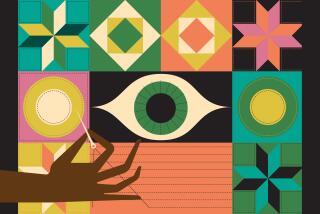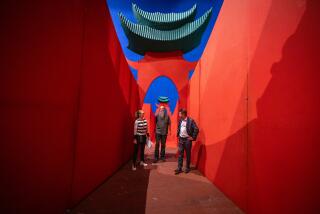It’s a Plush Velvet World
- Share via
“SOMEONE NICKNAMED ME ‘SWAGS,’ ” SAYS Steve Markham of West Hollywood, “but I call myself a preservationist.” The 78-year-old former vaudeville performer and classical music radio host has been collecting and restoring vintage theater drapes for 12 years. Several of his 25-plus pieces have been on view this month during the L.A. Conservancy’s “Last Remaining Seats” classic film series, which continues June 20 with Errol Flynn in “The Adventures of Robin Hood” at the Los Angeles Theater and closes July 11 with the Mexican film “Santa” at the Million Dollar Theater downtown. Markham has “draped” the series since 1989.
Markham still recalls the fateful day when, at 18, he saw “plush velvet burgundy drapes with magnificent swags” at a civic center opening in Kansas City. “That started me,” he says. A few years later, while stationed in New Guinea, he “made lovely drapes with lovely swags [valances] from white silk parachutes” for a theater built “in the middle of the jungle.” Decades later, Markham’s involvement with refurbishing downtown’s Orpheum Theatre set him on the road to collecting and restoration.
Markham finds most of his drapes (which typically measure 30 by 50 to 60 feet and can weigh more than 200 pounds) at theatrical warehouses and old theaters. His first acquisition, in 1989, a black velvet classic with a rhinestone fountain design dating from about 1925, was “wadded up in the basement of the Million Dollar.” His favorite (“I call it my jewel”) is made of black netting, accented with gold braid and faux gems. The netting can be layered against red velvet, silver lame or whatever the show calls for.
Markham calls his most outrageous find the “harem drape.” “It came out of ‘Gypsy,’ a traveling show,” he says. “I think it was used in a harem scene. It’s multicolored filmy material with tons of silver tassels and fringe. It gets applause every time I use it because it’s so over the top.”
Some distressed drapes are beyond Markham’s safety pin and glue methods. “All the elaborate stuff I take to a professional shop,” he says. He also has contracted artists to freshen up faded painted-on designs or add new elements, usually to mask unseemly holes or stains.
He hasn’t invested much time researching the provenance of his drapes, which can cost him from $5,000 to $10,000. He just knows what he likes and what works. Being a connoisseur has its drawbacks, though, principally a horror of tacky drapes. Some establishments, he says, “put in a plain rag, an old rag, junk. It’s disgraceful. I wouldn’t hang it in my kitchen.”
More to Read
The biggest entertainment stories
Get our big stories about Hollywood, film, television, music, arts, culture and more right in your inbox as soon as they publish.
You may occasionally receive promotional content from the Los Angeles Times.










